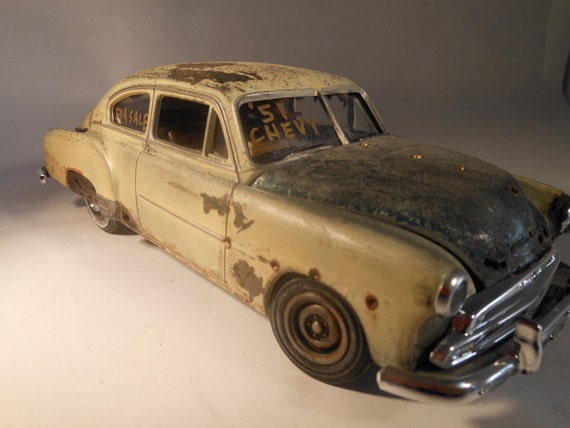Since watching
this video, a couple of weeks ago, the principles of this man's work have been on my mind a lot lately.
The video shows the work of
John Findra, who creates mini classic car replicas. He looks for old cars in the junkyard or the forest and studies them to make a mini duplicate. What struck me about his process is how he studied and included
all of the details of the wrecked cars-- "the shape of the rust hole, how the paint peels, the pattern that the glass makes as its breaking." Each of the cars 'imperfections' were transferred to his replicas and not only gave them character, but made them beautiful.
1951 Chevy Fleetline; 1/24 size
Here is what he says:
"I think we're in a world now where perfection is so tantament to success. That perfection almost becomes boring. I mean a car in its original state is a man made idea of perfection. But when you take that car and put it out in nature, nature now takes over and creates its own perfection. Nature has its way of reacting to metal and rubber and how the sun works on that car. These are all natural perfections that I am trying to incorporate into my work as an answer to the man made perfection that we see every day."
"[Looking at and taking pictures of old rusted cars] is my field work. Research."
"What I try to do in my models is to tell a story. What happened to that
car after somebody left it in the weeds? To rust.. and to decay?"
"What I'm really into now is getting the drip lines down the car. So what I'm going to do is put some colour here and drip it down as if its the rain coming down the body. Now I'll take some silver.. just to give it some subtle irregularity. The gold is terrific because it really does show up in the dark surface. So now you're really getting the feeling of distressed and out in the weather and being uncared for."
"I would say over my lifetime, I must have built thousands of models. I would spend hours shining them, polishing them, and it got boring."
"Probably as a younger man, I wouldn't have been able to accomplish this. In the earlier years, you are reaching for perfection. You want to attain great goals. But as you grow older you become more reflective and you can be imperfect. You can look at things from a different angle. And now I think that in my imperfection, I have created perfection."
I have been transferring these principles to my own art work. Its not about making the subject look perfect, its about capturing the nature of it. Honouring the things that make it imperfect. Sometimes that includes making the piece more about its imperfections than its perfections. What makes it unique? How can I express that? What are the factors contributing to its state? How can I tell its story? Creating a beautiful piece is about including things that at first glance were not important to include and in the end, celebrating those aspects, as they contribute to it's authenticity.
Over the past few months, I have been busy creating items, and have done quite a bit of work in coffee shops, the library, at home, and in the seniors woodworking club (every Thursday). I am waiting to show my items all at once. I have decided on a paint to use, however since it is hard to come by, still need to purchase it. I hope to post my logo soon. My items will be revealed publicly, in sequence, and just as I open my shop. Still lots to do!

